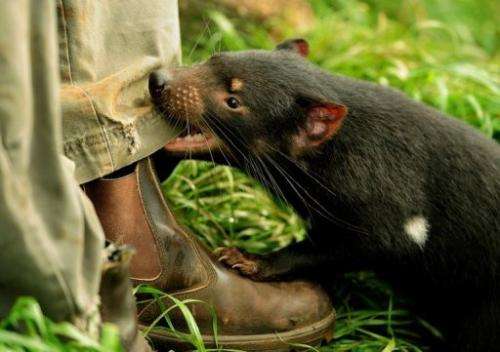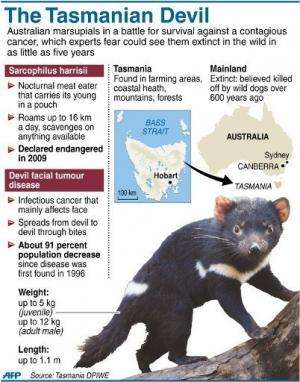'Gentler devil' hope for threatened marsupial

Could the Tasmanian devil, a ferocious marsupial threatened by facial tumours spread by biting, be saved by a change of character? Zoologists think there's a chance.
The wild population of devils has slumped by more than 90 percent since the facial cancer first surfaced in 1996, and there is neither a cure nor a vaccine.
But a four-year investigation by a team led by Rodrigo Hamede of the University of Tasmania found something intriguing: the less often an animal was bitten, the likelier it was to become infected.
The finding is "surprising and counter-intuitive," said Hamede.
"In most infectious diseases, there are so-called super-spreaders, a few individuals responsible for the transmission. But we found the more aggressive devils, rather than being super-spreaders, are super-receivers."
The reason, said Hamede: The more aggressive devils are likelier to bite than be bitten. As a result, they bite the mouth tumours of less aggressive devils and thus become infected.
The finding opens up a way of nurturing colonies of devils that favour less aggressive animals, he hoped.
"We need more detailed data on devil behaviour to define 'shy' or 'bold' types," said Hamede.

"We could use this information to develop a management strategy to reduce the spread of the disease by boosting natural selection of less aggressive, and therefore more resilient, devils."
Monitoring devils will give the key as to which animals are the most promising candidates.
The rat-like carnivores are reclusive but social creatures, which sleep by day and forage by night. They do not live in groups but encounter each other quite often, for mating or feeding around carcasses, and this is when they bite each other.
The disease is transmitted through cancer cells that break away from the tumour and infect the biter.
Devils once roamed Australia and at one point were considered by colonial farmers to be a pest. Since about 1600 they have been isolated to Tasmania, an island state south of the mainland.
They got their name for guttural cries that prompted early British settlers to call them "devils."
The study appears in the Journal of Animal Ecology, published by the British Ecological Society (BES).
More information: Rodrigo K. Hamede, Hamish McCallum and Menna Jones (2012). 'Biting injuries and transmission of Tasmanian devil facial tumour disease', doi: 10.1111/j.1365-2656.2012.02025.x, is published in the Journal of Animal Ecology at 21:00 GMT on Monday 3 September 2012.
(c) 2012 AFP




















